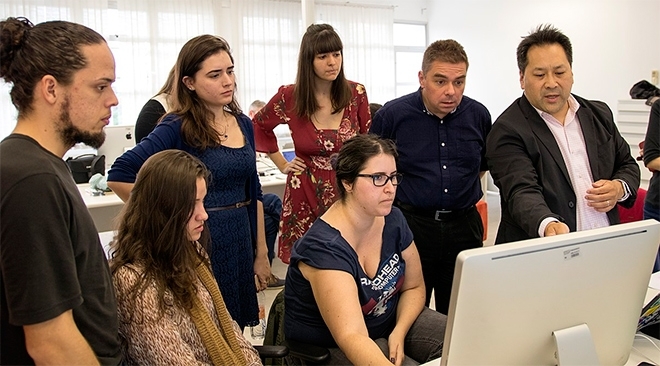

The Research, Innovation and Dissemination Center for Neuromathematics (NeuroMat) has created more than 4,000 Wikipedia entries and improved more than 21,000 (photo: Rodrigo Argenton)
The Research, Innovation and Dissemination Center for Neuromathematics (NeuroMat) has created more than 4,000 Wikipedia entries and improved more than 21,000.
The Research, Innovation and Dissemination Center for Neuromathematics (NeuroMat) has created more than 4,000 Wikipedia entries and improved more than 21,000.

The Research, Innovation and Dissemination Center for Neuromathematics (NeuroMat) has created more than 4,000 Wikipedia entries and improved more than 21,000 (photo: Rodrigo Argenton)
By Maria Fernanda Ziegler | Agência FAPESP – Wikipedia’s mathematics content in Portuguese has become more consistent, reliable and comprehensive in the last two years, thanks to the Research, Innovation and Dissemination Center for Neuromathematics (NeuroMat). One of the Research, Innovation and Dissemination Centers (RIDCs) funded by FAPESP, NeuroMat is now the world’s leading creator of structured mathematics content for the online encyclopedia, according to Wikipedia’s institutional statistics unit.
Wikipedia is written collaboratively and serves as a medium for the dissemination of scientific content to a range of audiences. NeuroMat’s dissemination task force has thus far resulted in 19.6 million pageviews for mathematics content on Wikipedia.
The task force created 4,240 new entries and improved 21,800. Searches and pageviews involving these entries increased almost instantly after they were improved by NeuroMat. The most viewed entry, Standard Deviation, had racked up 294,000 pageviews by June 2018, followed by Median with 204,000.
“Do you know how many youngsters are enrolled in high schools in Brazil? Eight million. Our collaboration with Wikipedia has succeeded in disseminating math content to many more people,” said Fernando da Paixão, NeuroMat’s head of dissemination.
The content disseminated by NeuroMat goes beyond the high school syllabus. The team began by selecting 14 entries to work on, including Normal Distribution and Probability Distribution. All were considered fundamental to statistics and consistent with the aim of creating open educational resources on the internet. They were developed, improved or expanded, and each one receives 200,000 pageviews per month on average. Next, the team created complete entries for more advanced concepts developed by NeuroMat itself.
The team also write new or improved entries on topics that blend neuroscience and mathematics, such as Parkinson’s Disease, Alzheimer’s Disease, and Brachial Plexus Injury.
“Before we began, the Portuguese-language version of Wikipedia had less than a quarter of the math content available in English, for example. Today, there’s much more,” said João Alexandre Peschanski, a professor at the Cásper Líbero School of Journalism in São Paulo and one of the coordinators of the initiative at NeuroMat.
Research centers often collaborate with Wikipedia, according to Peschanski, especially in North American countries, either as an institutional effort or as a voluntary initiative by researchers to disseminate related content and bolster the reliability of its entries.
NeuroMat’s content dissemination via Wikipedia began in response to internal demand. “We’re a multidisciplinary center, and we realized some terms could have different meanings depending on the researcher’s specialty. For example, ‘significance’ means different things to a biologist and a statistician,” Peschanski said.
Disseminating dissemination
Alongside the team’s work to extend and improve Wikipedia’s mathematics content, NeuroMat created a forum for the discussion of wiki-based dissemination practices. This development led to the first Wikipedia scientific initiation scholarship in Brazil, “Edit-a-thons” – text editing marathons for Wikipedia – and technical training sessions called Wikidata Labs with specialists and experienced Wikipedia collaborators. The last edition of Wikidata Labs, held in June 2018, was attended by two Wikimedia project international names, Andrew Lih, from American University, Washington DC, and Magnus Manske, from Wellcome Trust Sanger Institute, Cambridge, UK.
In response to the team’s experience of disseminating content via Wikipedia and developing a work method, they were contacted by other museums and research centers interested in doing the same thing. “We began to disseminate dissemination,” Paixão said.
One of the projects undertaken in partnership was the dissemination of videos, images and teaching material from the Matemateca, a mathematics library developed with the University of São Paulo’s Mathematics & Statistics Institute (IME-USP) for use by teachers and laypeople alike.
Another partnership resulted in the dissemination of photographs from the collection of the same university’s Veterinary Anatomy Museum (MAV-USP) via Wikipedia, giving students, academics and the general public access to more than 400 image files. Examples include a cow’s stomach and a horse’s lung.
NeuroMat has also partnered with Museu do Ipiranga to offer open access to digitized artwork on Wikipedia.
“This has everything to do with the open science philosophy that we espouse here at NeuroMat and that is also the basis for Wikipedia,” Peschanski said.
Republish
The Agency FAPESP licenses news via Creative Commons (CC-BY-NC-ND) so that they can be republished free of charge and in a simple way by other digital or printed vehicles. Agência FAPESP must be credited as the source of the content being republished and the name of the reporter (if any) must be attributed. Using the HMTL button below allows compliance with these rules, detailed in Digital Republishing Policy FAPESP.





